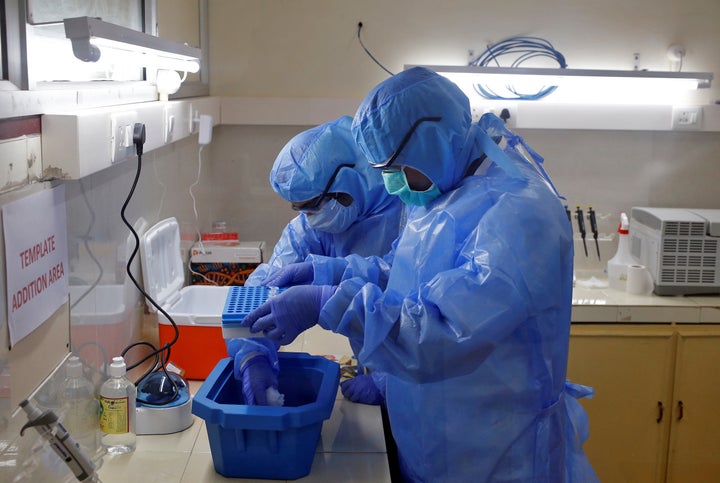
Hyderabad, TELANGANA — At least six separate teams of Indian companies are in the race to develop a vaccine for COVID-19, the illness caused by the novel coronavirus, but researchers warn mass immunisations could be as far as four years away.
Developing a safe and reliable vaccine will take between 18 and 24 months even with unprecedented support from regulators and investors, researchers working on a vaccine told HuffPost India. Mass-producing the vaccine in sufficient quantities could take at least another two years, offering a sobering glimpse of what life could look like even after May 3, 2020 — the day India’s punitive national lockdown is scheduled to end.
Dr. Anand Kumar, the managing director of Indian Immunologicals Ltd (IIL), said that his institute could be one of the first to be ready with a COVID-19 vaccine for commercial production in two years. However, developing a vaccine alone will not suffice as manufacturing could be the next hurdle, IIL authorities said.
“It is one thing to develop a vaccine and quite another to scale up and make millions of doses to supply for large countries,” said Dr. Prasanna A. Deshpande, Deputy Managing Director of IIL, a subsidiary of National Dairy Development board working on a vaccine in collaboration with Griffith University, a public research university in Australia. The dosage or the micrograms of vaccine which will constitute a dose, can be determined only when clinical trials begin, Dr. Deshpande said.
“People ask us when we can return to normal, or what was the normal way of life before January 2020. The only way back to that normal is sufficient vaccination,” Dr. Deshpande said. “Once we have a significant portion of our population vaccinated, we would have herd immunity in our population and eventually all over the world.”
Yet, several time-consuming steps lie between today and a future where at least 70% of India’s population has some form of immunity to the novel coronavirus. The 70% threshold is widely believed to be when a population achieves “herd immunity”, ie, when sufficiently large numbers of people are immune to the virus to halt its widespread transmission.
“Even with accelerated investment and approvals, it will take anywhere between two and three years for the vaccine to be available in sufficient quantities all over the world for the population to develop herd immunity. And even that timeframe is ambitious,” Dr. Deshpande said.
Racing against time, but carefully
IIL is one of 78 teams working on a COVID-19 vaccine globally, according to the Coalition for Epidemic Preparedness Innovations (CEPI). Other Indian teams include Bharat Biotech, Biological E. Limited, Zydus Cadila, Serum Institute of India and Mynvax.
According to IIL authorities, most of these companies are in the exploratory stage of vaccine research, during which researchers try to pick one virus prototype out of a pool of genetically modified viruses meant to trigger an immune response.
While the Serum Institute of India is believed to be the furthest along the road, the success of this company’s project will depend on clinical trials conducted by its research partners at Oxford University. Oxford University started the trials on April 25 this year, administering a prototype of their vaccine to 800 people to test if it is safe for humans.
Only five other teams, three of whom are from China, are at the stage of conducting the second stage of human trials during which the efficacy of the vaccine is calculated to determine dosage.
Past experience suggests new vaccines, especially those for a new virus like SARS-CoV-2, take upto a decade worth of research, and another six years to scale up manufacturing, said Dr. Anand Kumar, IIL’s Managing Director.
“Unlike other pharma products, vaccines are administered to healthy individuals and we have to be extremely careful about the safety of the product,” Dr. Kumar said. “In India, vaccine development and manufacturing are regulated by both the centre and the state governments. The process has been time-consuming.”
Once a possible vaccine has been identified and toxicology studies are conducted on small animals and non-human primates, researchers conduct a series of clinical trials on increasingly large groups of volunteers. Most of these volunteers are aged between 18 and 55 years. “A similar clinical trial will have to be undertaken later on individuals below 18 years with required approvals,” Dr. Kumar said.
In the case of COVID-19, Indian regulators have announced they will fast-track all regulatory clearances. But the work of science can only be accelerated up to a point for fear of violating norms set by the World Health Organisation and other regulatory bodies.
Testing the toxicity of a proposed virus, for instance, requires access to genetically modified lab-mice.
“Through our partner Griffith University, we have identified a lab in the US which has transgenic mice with receptors that are similar to human receptors,” Dr. Kumar said.
Manufacturing maladies
Once a vaccine has been identified and the effective dosage measured in micrograms is determined, manufacturing companies must ensure they are set up to produce at scale.
“The time for manufacturing depends on the size of the plant. If an entity has to build a plant from scratch, it will take more time to manufacture,” said Dr. Deshpande. “If it is about manufacturing the vaccine in an existing plant, the number of doses that can be manufactured will depend on the size and efficiency of the equipment including bioreactors, filters, centrifuges, purification equipment and filling line.”
Some of the ambitious timeframes announced by teams around the world, Dr. Deshpande said, do not seem to consider the time required to scale up manufacturing.
At IIL, said Managing Director Anand Kumar, the fastest route to mass immunisation was through collaboration rather than competition.
“With more number of players working on development of the vaccine, we will surely have results even if it takes time,” he said. “Once the vaccine is developed, IIL will ensure that it is available at an affordable price.”